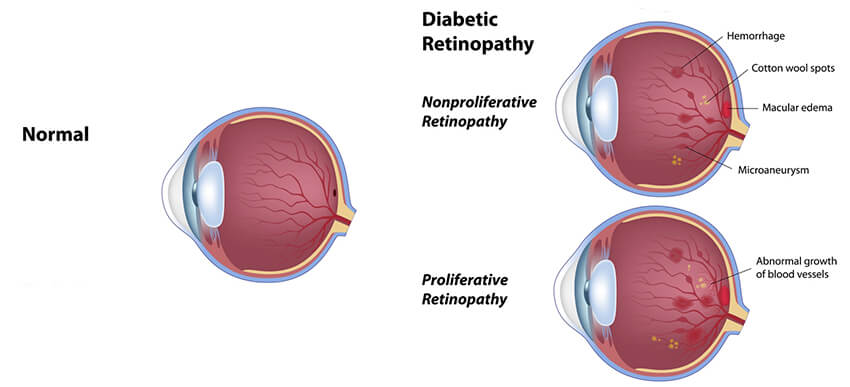Diabetes is a systemic or total body disease that has many effects on your body. From the standpoint of your eyes, regular examinations are recommended because of the specific risks that diabetes poses to your eyes. It is especially important to follow through with these eye examinations on a regular basis because many of the problems diabetes can create in the eye are treatable. Early detection and appropriate treatment of diabetic eye disease has been shown to preserve vision. Remember that you are usually not aware of the eye disease until it causes permanent damage.

All diabetics understand the need to keep their sugar levels and diet under control. Fluctuating glucose levels and sustained elevation of blood glucose have both been demonstrated to increase the risk of diabetic eye disease. Smoking further increases that risk. While no one can lead a”risk free” life, smoking with diabetes is both sight threatening and life threatening.
For the eye, diabetes usually shows up first in the retina. Like the film in a camera, your retina has one job in your eye: turning light into images for your brain. Diabetes can be thought of as a disease of small blood vessels. As the small blood vessels that nourish the retina lose function, they spring small leaks, allowing fluid to pass into the retina. This causes swelling of the retinal tissues, interfering with the retina’s ability to do its job. The result is blurred vision that cannot be improved with glasses. In many cases, lasers can be used to seal up the leaks, often allowing for recovery of vision as the leakage stops and fluid is reabsorbed.
As a result of vessel damage in diabetes some parts of the retina don’t get as much oxygen as they need. In response, the retina sends out chemical signals for the body to create new blood vessels. Unfortunately, these new vessels have a tendency to break and bleed easily. With blood inside the eye, the vision gets very smoky. Also, scar tissue may form, permanently reducing vision. In a series of studies performed in the 1980’s and still recognized for their superb design today, eye MD’s or ophthalmologists determined that the timely use of lasers to decrease these signals for new blood vessels to form helped preserve vision, and prevent bleeding and scar tissue formation.
In addition to diabetic retinal disease, diabetics are at increased risk for cataracts, glaucoma and infections. Maintaining regular care with your eyecare professional is the key to minimizing your risk of permanent vision loss.

 (603) 524-2020
(603) 524-2020 Order Contact Lenses
Order Contact Lenses Pay Your Bill Online
Pay Your Bill Online



